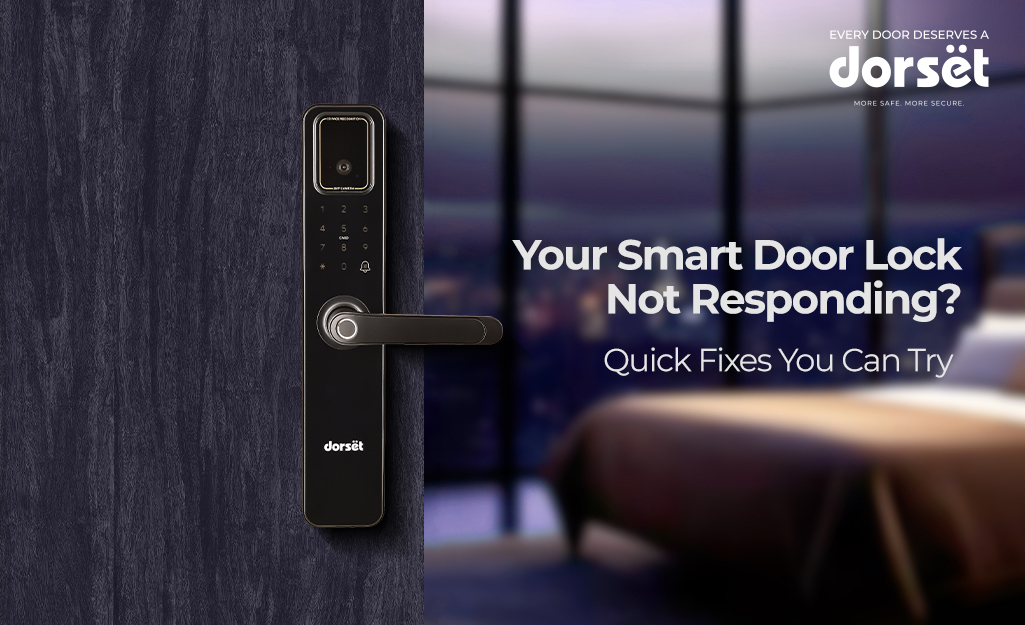
Even the best smart locks can act up sometimes. You might think something’s seriously wrong when your lock won’t respond but in most cases, it’s something small and totally fixable. At Dorset, we build high-quality smart door locks designed for everyday ease, but we know that even the smartest tech can hit a glitch now and then. The good news? Most of these issues look bigger than they are and can be solved in just a few minutes. Before you panic or call for help, try these quick fixes that often get things working again in no time.
Check Your Power Source First
The most common reason your smart lock isn't responding is also the simplest, dead or low batteries. It's easy to forget that smart door locks need power to function, especially if you've been enjoying months of trouble-free operation.
Most smart locks will give you warning signs before the batteries die completely. You might notice slower response times, dimmer LED indicators, or intermittent connectivity issues. If your lock has suddenly stopped responding entirely, start by replacing the batteries with fresh, high-quality ones. Even if your lock showed a decent battery level recently, batteries can sometimes drop quickly, especially in extreme temperatures.
After replacing the batteries, give your lock a few minutes to fully boot up before testing it. Some models need time to reconnect to your Wi-Fi network and sync with your mobile app.
Reset Your Connection
Wi-Fi connectivity issues are another frequent culprit behind unresponsive smart locks. Your digital lock might have lost connection to your home network due to a router restart, network changes, or temporary internet disruptions.
Try these connectivity fixes in order:
- Check if other devices in your home are connected to Wi-Fi properly
- Move closer to your router and test the lock again
- Restart your home router by unplugging it for 30 seconds, then plugging it back in
- Delete and re-add your lock in your smart home app
Sometimes your lock maintains its basic functions like keypad entry and even biometric access but loses smart features because of connectivity issues. If it is still working fine as a biometric door lock but app control fails, the problem is almost certainly network-related.
Examine the Physical Installation
Smart door locks are advanced devices, but they still rely on proper physical installation to function correctly. Over time, doors can shift, screws can loosen, or components can become misaligned, causing your lock to struggle or stop working entirely.
Check that your lock sits flush against the door and that nothing is obstructing its movement. Look for signs that the door has shifted like gaps around the frame, difficulty closing, or visible misalignment. Sometimes small shifts can prevent your lock's motor from operating properly.
If you notice the lock trying to operate but failing to complete its cycle, this often indicates a mechanical obstruction or alignment issue rather than an electronic problem.
Update Your Software and Apps
Outdated software can cause communication problems between your lock, your phone, and your home network. Both your smart lock's firmware and your mobile app need regular updates to maintain compatibility and security.
Check your app store for updates to your lock's companion app, and look within the app for any firmware update notifications for your lock itself. Some updates happen automatically, but others require manual approval. If you've been postponing updates, now is the time to install them.
After updating, you may need to reconnect your digital lock to your network or recalibrate certain settings, so be prepared to spend a few extra minutes setting things up again.
Perform a Factory Reset
When other solutions haven't worked, a factory reset often resolves stubborn problems. This returns your lock to its original settings and clears any corrupted data or conflicting configurations.
Before performing a factory reset, make sure you have your setup information handy, as you'll need to reconfigure everything from scratch. The exact reset procedure varies by model, but it typically involves holding specific buttons for a certain duration or following a sequence of actions outlined in your user manual.
After resetting, you'll need to reconnect your lock to your Wi-Fi network, reconfigure user codes, and set up any automation or integration features you were using previously.
When to Call for Professional Help
Most smart lock issues can be resolved with these basic troubleshooting steps, but some problems require professional attention. If you've tried all these solutions and your digital lock still isn't responding, or if you notice any of these warning signs, it's time to contact support:
- Visible damage to the lock housing or door frame
- Burning smells or unusual heat from the lock
- Repeated failures even after factory resets
- Mechanical sounds that suggest internal component damage
Prevention Is Better Than Cure
Regular maintenance can prevent many responsiveness issues before they occur. Replace batteries proactively rather than waiting for low battery warnings, keep your apps and firmware updated, and periodically check that your lock's physical installation remains secure and properly aligned.
Most smart lock problems have straightforward solutions, and with a bit of systematic troubleshooting, you can often restore your lock to full functionality without professional help. The key is working through potential causes methodically rather than assuming the worst when your lock stops responding.
Remember, smart locks are reliable devices, but like any technology, they occasionally need a bit of attention to keep running smoothly.